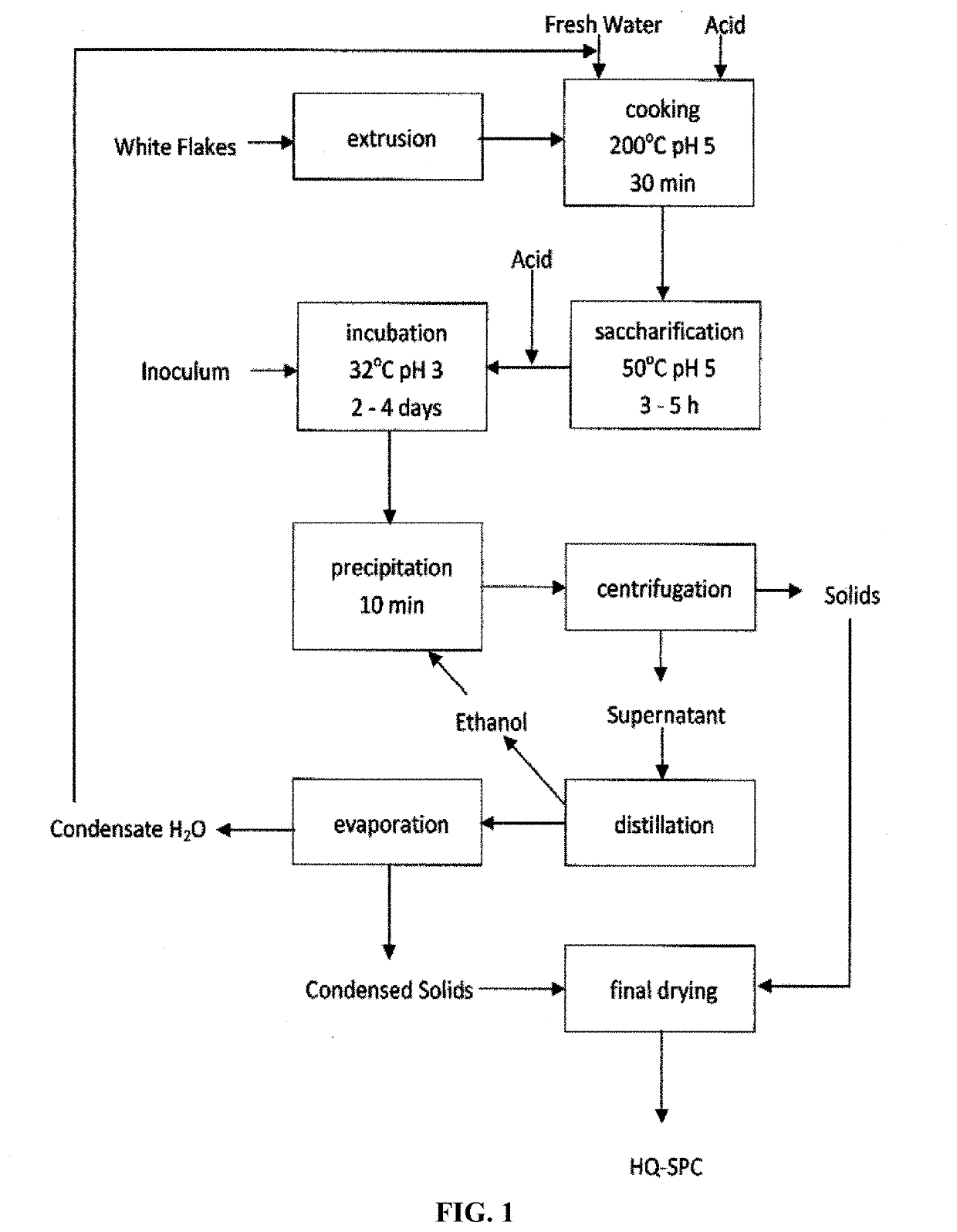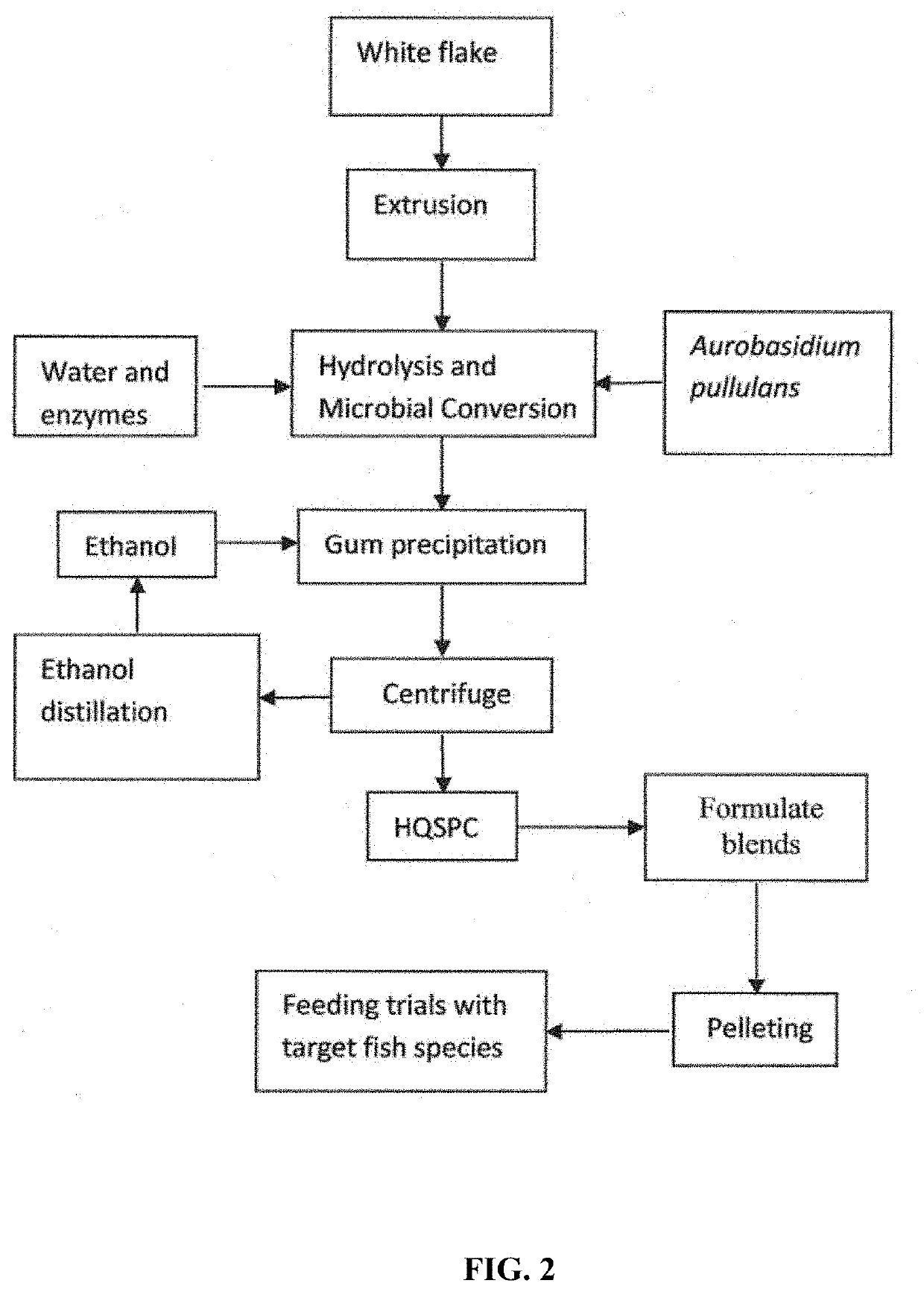Microbial-based process for improved quality protein concentrate
a technology of protein concentrate and incubation process, which is applied in the field of incubation processes, can solve the problems of current solvent extraction process cost, deficiency of critical amino acids (e.g., taurine) required by carnivorous marine fishes, and unsustainable, so as to reduce the amount of fresh solvent and increase the yield and recovery of proteinaceous materials.
- Summary
- Abstract
- Description
- Claims
- Application Information
AI Technical Summary
Benefits of technology
Problems solved by technology
Method used
Image
Examples
example 1
ity Protein Concentrate (HQPC) (Precipitation Method)
[0177]FIG. 1 shows an approach to pre-treating white flakes, converting sugars into cell mass (proteinaceous material) and gum (e.g., exopolysaccharides), recovering HQSPC and generating aquafeeds (FIGS. 2 and 4), and testing resulting aquafeeds in fish feeding trials for a process. White flakes were first subject to extrusion pretreatment (BRABENDER PLASTI-CORDER SINGLE SCREW EXTRUDER Model PL2000, Hackensack, N.J.) at 15% moisture content, 50° C., and 75 rpm to disrupt the structure and allow increased intrusion of hydrolytic enzymes during subsequent saccharification. These conditions provided a shearing effect against the rigged channels on both sides of the barrel, and it had been observed previously that this resulted in 50-70% greater sugar release following enzymatic hydrolysis. Extruded white flakes were then ground through a 3 mm hammermill screen, blended with water to achieve a 10% solid loading rate, and adjusted to p...
example 2
omparison Between Precipitation (ppt) Method, 3× Wash and 1× Wash Methods
[0185]HQPC from soy bean was obtained by the methods as substantially recited above and as illustrated in FIGS. 6-9, for both a 3× wash and 1× wash cycle. Comparison of resulting compositions for the ppt method (HQSPC Trial 5 and Trail 6), 3× wash and 1× (HQPC) wash are shown in Table 2.
TABLE 2Composition of the resulting proteins concentrates from ppt method,3x and 1x wash methods (g / 100 g, dry matter basis (dmb)).HQSPCHQSPCHQPC 3xHQPC 1xProtein SourceTrial 5Trial 6WashWashProximate ComponentsProtein61.6156.8675.30 69.17 Moisture*5.147.893.874.42Lipid1.701.262.731.89Crude Fiber0.814.864.847.23Ash8.825.211.812.37Amino AcidsAlanine2.712.662.832.92Arginine2.443.654.534.23Aspartic Acid6.726.457.777.15Cystine0.870.880.911.00Glutamic Acid8.708.8511.82 10.76 Glycine2.672.512.702.67Histidine1.411.401.661.62Hydroxylysine0.810.10NDNDHydroxyproline0.100.07NDNDIsoleucine2.892.923.232.79Lanthionine0.000.00NDNDLeucine4.644....
example 3
s of Soybean Meal by Temperature
[0186]A 10% (w / v) soybean meal slurry was prepared using hexane extracted soybean meal in water. The pH of the slurry was set at 4.5 and the slurry was agitated to obtain mixing. The soybean slurry was heated at a temperature of 100° C. before fermentation. The heated mash was incubated with the fermentative organism. The heated mash with no fermentative organism was treated with FLAVORZYME® (Protease from Aspergillus niger, purchased from Sigma) at a loading rate of 30 mg / g soybean meal and was used as control. The sample was incubated at 30° C. for 12 hours. Post incubation, the samples were heated at 80° C. for 2 minutes to inactivate the protease.
[0187]The mash was heated to 100° C. for 1.5 minutes. The samples were centrifuged at 4000 rpm for 10 seconds. N-acetyl cysteine (3.33% w / v) was prepared in boric acid buffer (0.12 M and pH 10.4). 16.67 μL of the sample supernatant was added to 1000 mL of N-acetyl cysteine. The absorbance was measured at ...
PUM
| Property | Measurement | Unit |
|---|---|---|
| Temperature | aaaaa | aaaaa |
| Temperature | aaaaa | aaaaa |
| Fraction | aaaaa | aaaaa |
Abstract
Description
Claims
Application Information
 Login to View More
Login to View More - R&D
- Intellectual Property
- Life Sciences
- Materials
- Tech Scout
- Unparalleled Data Quality
- Higher Quality Content
- 60% Fewer Hallucinations
Browse by: Latest US Patents, China's latest patents, Technical Efficacy Thesaurus, Application Domain, Technology Topic, Popular Technical Reports.
© 2025 PatSnap. All rights reserved.Legal|Privacy policy|Modern Slavery Act Transparency Statement|Sitemap|About US| Contact US: help@patsnap.com



